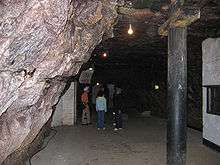Chislehurst Caves

Chislehurst Caves is a 22 miles (35 km) long series of tunnels in Chislehurst, Bromley, in Southeast London, England.
Overview
Today the caves are a tourist attraction and although they are called caves, they are entirely man-made and were dug and used as chalk and flint mines. The earliest mention of the mines is around 1250 and they are believed to have been last worked in the 1830s.[1]
During the early 1900s, the caves became a popular tourist attraction. In World War I they were used as an ammunition depot associated with the Royal Arsenal at Woolwich. They were used for mushroom cultivation in the 1930s.
During World War II, when the aerial bombardment of London began in September 1940, the caves were used as an air raid shelter. Soon they became an underground city of some 15,000 inhabitants with electric lighting, a chapel and a hospital. Shortly after VE Day the shelter was officially closed. One baby, christened Rose Cavena Wakeman, was born in the caves.
Mythology
In 1903, William Nichols, then Vice President of the British Archaeological Association, produced a theory that the mines were made by the Druids, Romans and Saxons.[2][3] This theory was used to give names to the three parts of the caves. Tour guides point out supposed Druid altars and Roman features. However this is at best speculation as the earliest documented evidence for a chalk cave is in 1737. An opposing article in the next issue showed the similarity of the workings to coal mines in the Newcastle area, and argued that most of the excavation had been made in the last two centuries and that the evidence for any dene-holes was slight.[4] The caves were used between 1830 and the 1860s for producing lime. The 25 inch to a mile (approx 1:2,500) Ordnance Survey map of 1862–63 describes the place as a "chalk pit" and marks an "engine house" and two remaining kilns.[5] A further investigation produced, among other evidence, a letter from the son of one of the workers.[6]
However, these stories proved attractive to tourists.
Other uses
In the 1960s, the caves were used as a music venue. David Bowie, who lived at 19 Bickley Road at the time, Status Quo, Jimi Hendrix, The Rolling Stones and Pink Floyd all performed there.[7] On October 31, 1974 a lavish media party was held there to celebrate the launch of new UK record company Swan Song Records by the band Led Zeppelin. More recently, some of the tunnels have been used by the live action role-playing game "Labyrinthe".[8] During the 1980s a Sidcup promoter known locally as Andy Ruw organised sixties nights in the caves, employing Chislehurst resident David Lewis as DJ and booking such acts as Brian Poole and the Troggs to perform there alongside a coverband named the Strolling Bones.
The caves have appeared in several television programmes including a serial in the BBC programme Doctor Who from 1972 titled The Mutants.[9] In an episode of Seven Natural Wonders presented by Bill Oddie, the caves were presented as one of the wonders of the London area. The caves were also used in the films The Tribe and Inseminoid and in a 2008 music video for the metal band Cradle of Filth.[10] It was filmed for two episodes of Most Haunted. A 20-year investigation into the hauntings of the caves by author James Wilkinson containing the testimonies of many of the guides and owners over a 50-year period was published in 2011 entitled The Ghosts of Chislehurst Caves.[11]
References
- ↑ "Chislehurst Caves, Kent". The Heritage Trail. Archived from the original on 2015-05-02. Retrieved Apr 18, 2015.
- ↑ Nichols, W. J. (1903). "The Chislehurst Caves and Dene-holes". British Archeological Association. IX (ns): 147–160. Retrieved Apr 18, 2015.
- ↑ Nichols, W. J. (1904). "The Chislehurst Caves and Dene-holes". British Archeological Association. X: 64–86. Retrieved Apr 18, 2015.
- ↑ Forster, T.E. and R.H. (Aug 1904). "The Chislehurst Caves". British Archeological Association. X (ns): 88–102. Retrieved Apr 18, 2015.
- ↑ Bonner, F.S.A., Arthur (1937). "The Chislehurst Cave Myth". Yorkshire Ramblers' Club Journal. 7 (23): 32–34. Retrieved Apr 18, 2015.
- ↑ Hayes, Rev J. W. (1909). "Deneholes and other chalk excavations". Royal Anthropological Institute. 39: 44–77. Retrieved Apr 18, 2015.
- ↑ Jelbert, Steve (September 8, 2000). "The Arts: Pop: Playing the field: access all areas". The Independent. Retrieved 2012-07-12.
- ↑ "Labyrinthe Venue". Retrieved 3 August 2016.
- ↑ http://www.chislehurst-caves.co.uk/Filming.html
- ↑ "Archived copy". Archived from the original on 2008-10-16. Retrieved 2014-04-28.
- ↑ Wilkinson, James (November 2011). The Ghosts of Chislehurst Caves. Witham, Essex: Greenlight Publishing. ISBN 978-1897738436.
External links
| Wikimedia Commons has media related to Chislehurst Caves. |
- Chislehurst Caves from the heritage trail
- Official web site
- Alternative web site
- Map sources for Chislehurst Caves
- Labyrinthe web site
Coordinates: 51°24′27″N 0°03′27″E / 51.4074°N 0.0575°E
